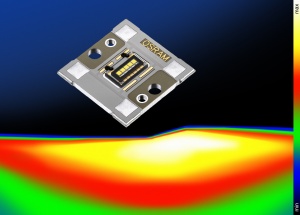Nov 11 2008
With its integrated shutter the new OSTAR Headlamp LED from OSRAM Opto Semiconductors simplified optical systems. They emit clearly defined light with high efficiency without the need for further external shutters. The high-power LED is now equipped with one, two, three, four or five chips and can be used for all imaginable headlamp designs. Different illumination patterns and lighting scenarios can be created. Instead of the usual silicon encapsulation a glass cover bonded to the frame protects the chips. It also prevents scatter losses.
 High-precision engineering, integrated shutter and optimized chip placement and package design make the new OSTAR Headlamp LED fit for all vehicle headlight functions. Source: OSRAM
High-precision engineering, integrated shutter and optimized chip placement and package design make the new OSTAR Headlamp LED fit for all vehicle headlight functions. Source: OSRAM
Depending on the number of chips arranged in series the OSTAR Headlamp LED produces between 125 lm at 700 mA (one chip) and 1000 lm at 1 A (five chips). The enormous brightness from an unchanged power rating of 12 W results from improvements in the chips themselves, the converter and the package. Thermal resistance for the five-chip version is around 3 K/W. “Development work is continuing of course”, said Peter Knittl, Head of Automotive Marketing LED at OSRAM Opto Semiconductors. “We expect there to be a continual reduction in thermal resistance to a much lower level than at present.” Knittl is also convinced that over the next few years there will be further drastic increases in brightness.
Different lighting scenarios
A high-precision shutter integrated in the glass provides a clearly defined beam pattern on the road without losing light, as was the case previously with mechanical shutters. Compared with conventional solutions the mounting depth is also significantly reduced. And the glass cover itself makes the LED more robust.
With a color temperature of 6000 K the light color is very close to that of natural daylight. This makes driving safer because drivers do not get tired so quickly. What’s more, oncoming drivers are not dazzled because headlight manufacturers can design the bright/dark transition areas with great precision. Different lighting scenarios can be created, such as high beam, low beam and cornering beam, by combining different chip configurations on which lenses can be mounted. Compared with classic HID projection systems, which emit 35 to 45% of the light produced, the LED solution emits 10% more. With a life of 10,000 to 20,000 hours, LEDs also outperform conventional solutions and in fact generally last longer than the vehicle itself.